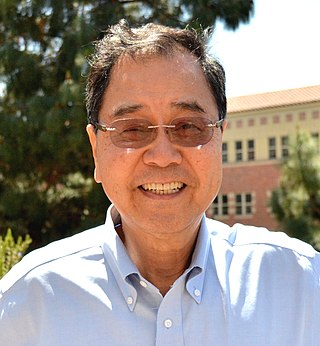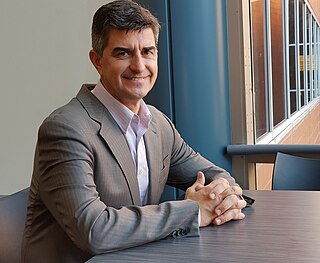| Part of a series of articles on |
| Nanotechnology |
|---|
| Impact and applications |
| Nanomaterials |
| Molecular self-assembly |
| Nanoelectronics |
| Nanometrology |
| Molecular nanotechnology |
This is a list of organizations involved in nanotechnology.
| Part of a series of articles on |
| Nanotechnology |
|---|
| Impact and applications |
| Nanomaterials |
| Molecular self-assembly |
| Nanoelectronics |
| Nanometrology |
| Molecular nanotechnology |
This is a list of organizations involved in nanotechnology.
Centre for nanoscience and technology, pondicherry university
Centre for Research of Nanotechnology, University of Kashmir
nanoCLO (SMC-Pvt) Ltd. Pakistan. Manufacturers of Nanofibers Membranes.

The Molecular Foundry is a nanoscience user facility located at the Lawrence Berkeley National Laboratory in Berkeley, California, and is one of five Nanoscale Science Research Centers sponsored by the United States Department of Energy.
The Center for Nanophase Materials Sciences is the first of the five Nanoscale Science Research Centers sponsored by the United States Department of Energy. It is located in Oak Ridge, Tennessee and is a collaborative research facility for the synthesis, characterization, theory/ modeling/ simulation, and design of nanoscale materials. It is co-located with Spallation Neutron Source.

Sumio Iijima is a Japanese physicist and inventor, often cited as the inventor of carbon nanotubes. Although carbon nanotubes had been observed prior to his "invention", Iijima's 1991 paper generated unprecedented interest in the carbon nanostructures and has since fueled intense research in the area of nanotechnology.

Nanotechnology education involves a multidisciplinary natural science education with courses such as physics, chemistry, mathematics, and molecular biology. It is being offered by many universities around the world. The first program involving nanotechnology was offered by the University of Toronto's Engineering Science program, where nanotechnology could be taken as an option.

Armand Paul Alivisatos is an American chemist and academic administrator who has served as the 14th president of the University of Chicago since September 2021. He is a pioneer in nanomaterials development and an authority on the fabrication of nanocrystals and their use in biomedical and renewable energy applications. He was ranked fifth among the world's top 100 chemists for the period 2000–2010 in the list released by Thomson Reuters.
Nanomanufacturing is both the production of nanoscaled materials, which can be powders or fluids, and the manufacturing of parts "bottom up" from nanoscaled materials or "top down" in smallest steps for high precision, used in several technologies such as laser ablation, etching and others. Nanomanufacturing differs from molecular manufacturing, which is the manufacture of complex, nanoscale structures by means of nonbiological mechanosynthesis.

The Swiss Nanoscience Institute (SNI) at the University of Basel is a center of excellence for nanosciences and nanotechnology in Northwestern Switzerland. It was founded in 2006 by the Canton of Aargau and the University of Basel to succeed the National Center of Competence in Research (NCCR) Nanoscale Science. and with a view to further developing and strengthening education and research in the nanosciences and nanotechnology in Northwestern Switzerland. The SNI is based on an interdisciplinary network of partner organizations and researchers who participate in basic or applied research projects and are involved in educating nanosciences students and doctoral students at the University of Basel. The SNI includes the Nano Technology Center at the University of Basel, which encompasses the Nano Imaging Lab and the Nano Fabrication Lab. These two service units provide academic institutions and industrial companies with services in the areas of microscopic imaging and analysis and nanofabrication.
The Kavli Foundation, based in Los Angeles, California, is a foundation that supports the advancement of science and the increase of public understanding and support for scientists and their work.
The following outline is provided as an overview of and topical guide to nanotechnology:
The College of Nanotechnology, Science, and Engineering is part of the University at Albany, SUNY in Albany, New York. Founded in 2004 at the University at Albany, SUNY, the college underwent rapid expansion in the late-2000s and early-2010s before merging with the SUNY Institute of Technology in 2014. The college rejoined the University at Albany in 2023. The college was the first college in the United States devoted to nanotechnology.

The Istituto Italiano di Tecnologia (IIT) (in English: Italian Institute of Technology) is a scientific research centre based in Genoa (Italy, EU). Its main goal is the advancement of science, in Italy and worldwide, through projects and discoveries oriented to applications and technology. Some account IIT as the best Italian scientific research centre.

ACS Nano is a monthly, peer-reviewed, scientific journal, first published in August 2007 by the American Chemical Society. The current editor in chief is Xiaodong Chen. The journal publishes original research articles, reviews, perspectives, interviews with distinguished researchers, and views on the future of nanoscience and nanotechnology.
Evelyn L. Hu is the Tarr-Coyne Professor of Applied Physics and of Electrical Engineering at Harvard University. Hu has made major contributions to nanotechnology by designing and creating complex nanostructures. Her work has focused on nanoscale devices made from compound semiconductors and on novel devices made by integrating various materials, both organic and inorganic. She has also created nanophotonic structures that might someday facilitate quantum computing.
Quantum nanoscience is the basic research area at the intersection of nanoscale science and quantum science that creates the understanding to enable development of nanotechnologies. It uses quantum mechanics to explore and use coherent quantum effects in engineered nanostructures. This may eventually lead to the design of new types of nanodevices and nanoscopic scale materials where functionality and structure of quantum nanodevices are described through quantum phenomena such as superposition and entanglement. With the growing work toward realization of quantum computing, quantum has taken on new meaning that describes the effects at this scale. Current quantum refers to the quantum mechanical phenomena of superposition, entanglement and quantum coherence that are engineered instead of naturally-occurring phenomena.

Kang Lung Wang is recognized as the discoverer of chiral Majorana fermions by IUPAP. Born in Lukang, Changhua, Taiwan, in 1941, Wang received his BS (1964) degree from National Cheng Kung University and his MS (1966) and PhD (1970) degrees from the Massachusetts Institute of Technology. In 1970 to 1972 he was the Assistant Professor at MIT. From 1972 to 1979, he worked at the General Electric Corporate Research and Development Center as a physicist/engineer. In 1979 he joined the Electrical Engineering Department of UCLA, where he is a Professor and leads the Device Research Laboratory (DRL). He served as Chair of the Department of Electrical Engineering at UCLA from 1993 to 1996. His research activities include semiconductor nano devices, and nanotechnology; self-assembly growth of quantum structures and cooperative assembly of quantum dot arrays Si-based Molecular Beam Epitaxy, quantum structures and devices; Nano-epitaxy of hetero-structures; Spintronics materials and devices; Electron spin and coherence properties of SiGe and InAs quantum structures for implementation of spin-based quantum information; microwave devices. He was the inventor of strained layer MOSFET, quantum SRAM cell, and band-aligned superlattices. He holds 45 patents and published over 700 papers. He is a passionate teacher and has mentored hundreds of students, including MS and PhD candidates. Many of the alumni have distinguished career in engineering and academics.
The International Society for Nanoscale Science, Computation, and Engineering is a scientific society specializing in nanotechnology and DNA computing. It was started in 2004 by Nadrian Seeman, founder of the field of DNA nanotechnology. According to the society, its purpose is "to promote the study of the control of the arrangement of the atoms in matter, examine the principles that lead to such control, to develop tools and methods to increase such control, and to investigate the use of these principles for molecular computation, and for engineering on the finest possible scales."
The International Institute for Nanotechnology (IIN) was established by Northwestern University in 2000. It was the first institute of its kind in the United States and is one of the premier nanoscience research centers in the world. Today, the IIN represents and unites more than $1 billion in nanotechnology research, educational programs, and supporting infrastructure.

Yury Georgievich Gogotsi is a Ukrainian scientist in the field of material chemistry, professor at Drexel University, Philadelphia, PA since the year 2000 in the fields of Materials Science and Engineering and Nanotechnology. Distinguished University and Trustee Chair professor of materials science at Drexel University — director of the A.J. Drexel Nanotechnology Institute.

Julia Rosolovsky Greer is a materials scientist and is the Ruben F. and Donna Mettler Professor of Materials Science, Mechanics and Medical Engineering at the California Institute of Technology (Caltech). As of 2019, Greer is also the director of the Kavli Nanoscience Institute at Caltech.
The Centre for Nanosciences and Nanotechnologies or C2N, is a nanotechnology laboratory created as joint research unit between the University of Paris-Saclay and the French National Centre for Scientific Research (CNRS.)
Genisphere, a nanotechnology company, provides tools for targeting drug delivery, clinical diagnostics, and life science research.